What’s Happening Here?
Ever find yourself walking the production facilities feeling pretty good about the crops ... and then you spot the first—and hopefully only—major problem? Growing plants can be so emotionally rewarding, yet so humbling at the same time!
Here's a recent problem I observed on a crop of Agastache Golden Jubilee:
I think you’d agree that something is not right with these plants. You can likely understand how seeing the appearance of this agastache can bring you down after observing other trouble-free perennials throughout the greenhouses. Yes, humbling indeed!
I can tell you this problem is somewhat common on agastache and I passed along a very subtle clue two sentences ago. Did you catch it? I'm just going to leave it like this for now and ask if you know: “What’s happening here?”
Enjoy the upcoming content. I’ll reveal the answer before signing off.
New Lilies from Unex
If you're in the market for perennial Asiatic and Oriental lilies, here are four pretty new ones from Dutch bulb exporter Unex:
|
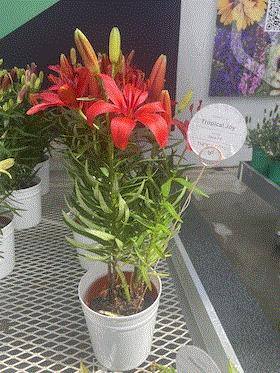
Asiatic Lily Tropical Joy
|
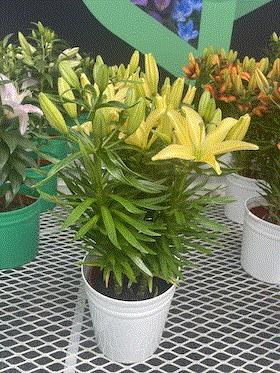 Asiatic Lily Jersey Joy Asiatic Lily Jersey Joy
|
Tropical Joy is a great compact two-tone colored Asiatic lily with red flower buds opening to robust red blooms with a slight blush of mango (orange) radiating from their cores. Grows approximately 16-in. tall. Hardy to Zone 3.
I’d describe Jersey Joy as having a delicate, soft yellow coloration and a compact growing habit similar to the other Joy cultivars, reaching 14- to 18-in. tall when blooming. Hardy to Zone 3.
|
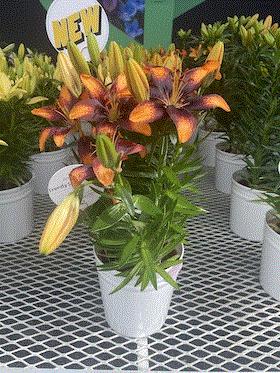
Asiatic Lily Trendy Las Palmas
|
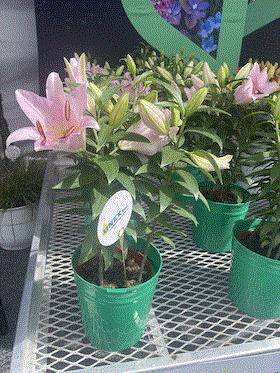 Oriental Lily Smart Romance Oriental Lily Smart Romance
|
Trendy Las Palmas has a unique color I’d describe as a combination of orange with chocolate brown (intense burgundy) centers. The chocolate coloration appears nearly solid in the center of the petals and becomes lightly speckled as it approaches the tips of the flower petals. Reaches 14- to 18-in. tall and is hardy to Zone 3.
Lastly, Smart Romance is an excellent pink cultivar of Oriental lily that has a nice compact habit (just 17-in. tall) and produces large, fragrant pink flowers. It has a quick production time—just 60 to 70 days—a whole month earlier than traditional Oriental varieties! Hardy to Zone 4.

Danziger’s Newest Additions
Erysimum SunStrong Orange Improved
Here’s a great Zone-6 perennial that keeps flowering and can be treated like an annual. Erysimum SunStrong Orange Improved is loaded with bright tangerine flowers. It’s fairly compact at 18- to 24-in. tall, doesn't require vernalization for flowering and is heat tolerant.
Salvia Apex
|
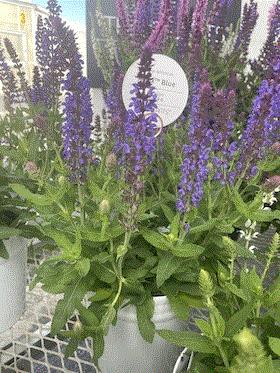 Apex Blue Apex Blue
|
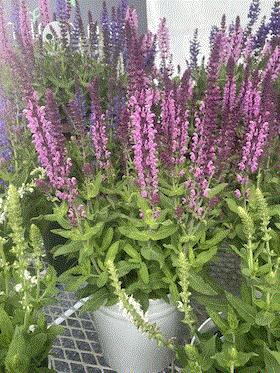 Apex Pink Apex Pink
|
The Apex series of salvia from Danziger offers early and uniform blooming with an abundance of colorful flower spikes held nicely above shorter-than-usual, deep green, lance-shaped foliage. They reach 14- to 18-in. tall when flowering and are great for attracting pollinators to the landscape. Apex Pink has rose-pink flowers and Apex Blue has intense violet-blue flowers. Hardy to Zone 4.
Recent Intros from Syngenta Flowers
Lithodora Tidal Pool Sky Blue
Here’s a plant I’ve always admired, but thought was reserved for more central to southern states. But with hardiness to Zone 5, I’m willing to give this new lithodora a try. Tidal Pool Sky Blue loves full sun and covers its low-growing foliage with true blue flowers in the mid spring.
Phlox GoldiPhlox
|

GoldiPhlox Lavender Eye
|
 GoldiPhlox Pink Improved GoldiPhlox Pink Improved
|
GoldiPhlox is a new series of Phlox subulata from Syngenta. Each cultivar has a spreading, low-mounding 3- to 6-in. habit and absolutely covers itself with tons of colorful flowers in the spring. They also bloom slightly earlier than traditional varieties on the market. Hardy to Zone 3.
The Answer is …

I shared this image at the top of the newsletter and asked if you could correctly diagnose the cause of this abnormal-appearing agastache. Let’s take a look from another angle to see if it helps you to confirm your answer:
Whenever I anticipate this problem, I like to look at the undersides of the leaves for further confirmation. Did you narrow down your final diagnosis? At the top of the newsletter, I mentioned there was a subtle clue in one of the sentences. Did you catch what it was? “You likely understand how seeing the appearance of this agastache can bring you down after observing other trouble-free perennials throughout the greenhouses.”
Okay, maybe it wasn’t a good clue when I used the word “down” to hint at “downy,” but please, give a guy a break!
There you have it: The answer I was looking for is downy mildew.
Let’s Continue
I don’t know how well you can see it in the image above, but there's no sporulation on the undersides of the agastache leaves. If you recall, when downy mildew usually occurs, sporangia is most often present on the undersides of the leaves directly below the discolored patches on the upper leaf surfaces. However, the fuzzy sporangia may not be present in all cases. When the sporangia are absent, it does make proper diagnosis a little more complicated, as other problems, such as foliar nematodes or bacterial diseases, can develop similar symptoms to these (angular patches bound between the veins).
Here's how downy mildew most commonly appears:
|
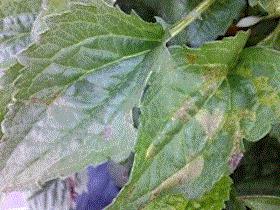
Rudbeckia upper leaf surface ...
|
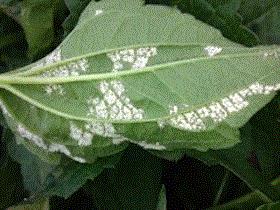
... and directly below the upper patches.
|
There are several perennials susceptible to downy mildew, including agastache, buddleia, coreopsis, geum, lamium, rose and rudbeckia, to name a few.
Infections most commonly begin with moist conditions and high humidity. A film of water on the leaves for more than six hours is sufficient for germination and entry. This can occur with either a morning dew event or with improperly timed irrigation events.
To reduce the likelihood of downy mildew infestations, maintain plants with dry leaves going into the night, increase the air circulation around the crop and irrigate early in the day to allow the leaves to dry as quickly as possible.
It's best to control downy mildew on susceptible perennials preventatively with fungicides. Some of my favorites and most effective fungicides for controlling downy mildew are Micora, Segovis, Segway O and Stature. There are other fungicides that work well preventatively, but this listing is the best of the best at controlling downy mildew diseases.




Thanks for reading this edition of Perennial Pulse. My email is paul@opelgrowers.com if you have any comments, article suggestions or if you'd just like to say hello.
Best regards,

Paul Pilon
Editor-at-Large—Perennial Pulse
Director of Growing—Opel Growers
This email was received by you and 34,939 other fine subscribers!
If you're interested in advertising in Perennial Pulse, contact Kim Brown ASAP and she'll hook you up.